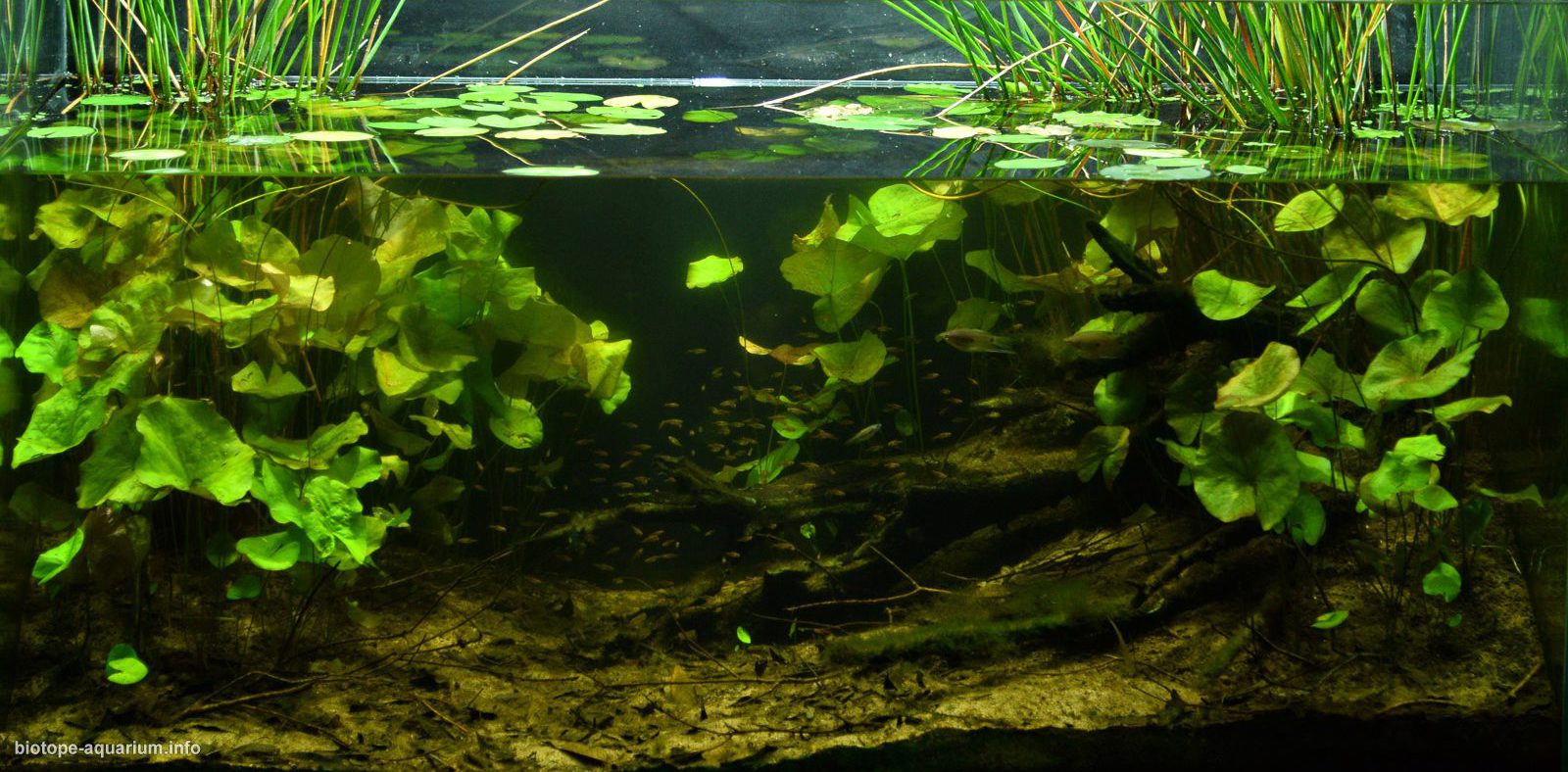Nature of aquatic life at season the water came bad, Tram Chim National Park of Dong Thap Muoi, Vietnam
18th place in Biotope Aquarium Design Contest 2018
![]() Vietnam. Tran Hoang Nghia
Vietnam. Tran Hoang Nghia

Volume: 290 L
Dimensions: 120x60x60 cm
List of fishes: Trichopodus trichopterus, Trichopsis pumila, Oxyeleotris urophthalmus, Boraras urophthalmoides, Metapenaeus sp.
List of plants: Nymphaea sp., Eleocharis dulcis
Description of decorations: Dried leaves, Melaleuca Driftwood.
Description of equipment: External filter JBL , fluorescent lamps T5 2х48 W, 10000 K, 6500 k, Led 50W.
Water parameters: Temperature is 28°C, pH is 6.5.
INFORMATION ABOUT BIOTOPE
Description of the area surrounding the biotope: Tram Chim National Park of Dong Thap Muoi, Tam Nong district, Dong Thap province, in the Mekong Delta. The plain of reeds was seasonally flooded with standing water for continuous periods of up to seven months per year. Since canalization, flood waters drain more rapidly and the national park is flooded for less than six months per year. Water levels in the canals begin to rise in June, at the beginning of the rainy season. Between September and December, the national park is inundated to a depth of 2 to 4 m, with a peak in October. The park is in the lowest area of the Mekong River water logged plain submerged and in the centre of Dong Thap Muoi. The climate is similar to that region close to the equator; it has a great deal of rainfall and sunlight. The vegetation of Tram Chim National Park comprises a mixture of seasonally inundated grassland, regenerating Melaleuca forest and open swamp. The seasonally inundated marshes at Tram Chim are the last extensive remnant of the freshwater marshes of the Plain of Reeds. The marsh plant commu-nities form a continuum, closely following the gradient of soil surface elevation andwater permanence. The Panicum repens (Poaceae) community is located on sandstones and old-alluvium formations, with an inundation time of 1-3 months a year. Tram Chim: Mekong River Basin (Vietnam) 3. Oryza ru fi (Poaceae) and Eleocharis dulcis (Cyperaceae) communities are located on the most depressed areas that can be flocked to 9-10 months a year. The Ischaemum rugosum (Poaceae) is located in the area of mediumelevation, with average fl ooding time 4-5 months a year. Lotus Nelumbo nucifera (Nelumbonaceae) is abundant in permanently inundatedswamps which are located on old riverbeds and shallow streams. In addition to Nelumbonucifera, many other aquatic plants are also found in lotus swamps such as Nymphaea nouchali, Nymphaea tetragona (Nymphaeaceae), Polygonumtomentosum (Polygonaceae), Ludwigia adscendens (Onagraceae), Nymphoidesindica (Menyanthaceae), and Hymenachne acutigluma (Poaceae). Tram Chim National Park is one of the few natural landscapes found today in Dong Thap Muoi. This park meets the criterion on national ecological parks in terms of terrain, ecological landscape of the Mekong River floodplain and its lower basin. The park is the habitant of Sarus crane – an extremely rare species recorded in the Red Book.
Description of the underwater landscape of the biotope: On the rain season, as the river passes through lowlands, said that weather condition has created favourable conditions for development the two Eleocharis and Nymphae; there are many branches and driftwood in the underwater. Where are home to fishs as Trichogaster trichopterus, Trichopsis pumila, Boraras urophthalmoides. Peak blooming, when the Aquatic plants are in full flower the same time at the breeding season of underwaater animals.
Description of the parameters of the habitat: Temperature is 28°C, pH varies from 6.3 to 6.8 depending on the rain season.
List of fishes and invertebrates occurring in the nature biotope: Trichogaster trichopterus, Trichopsis sp., Channa maculata, Anabas testudineus, Clarias batrachu, , Oxyeleotris urophthalmus, Boraras urophthalmoides.
List of plants found in the nature biotope: Nymphae lotus, Nymphoidesindicum, Pistia stratiotes, Nelumbo nucifera, Eichhornia crassipes, Salviniaceae, Ceratophyllaceae, Eleocharis dulcis.
Threats to the ecology: In the dry season, the pH decrease sharply, affecting the species, the fishs can’t our procreative powers.
Sources of information:
Comments of the members of the jury of Biotope Aquarium Design Contest 2018

Without taking into account the emerged part, the design looks very natural. The detritus in the background, covering the wood together with algae and for a long time submerged wood provide a very natural touch, just as I have observed in some nature aquatic biotopes. Very good job!

Nice tank, interesting local biotope. BUT bad combination of fishes and way too many. Sadly enough.
